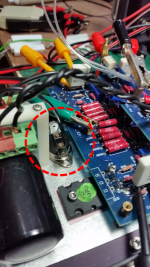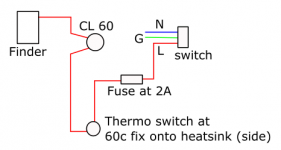You have 4 trimpots for 4 FETs.
After you reduce the offset on one output, and your bias has changed, you can readjust both trimpots on that side to get the bias back.
Try to read the build instructions and understand how things work.
Patrick
Sometimes the turns doesn't register on the DMM quick enough. Sometimes it overshoot with just a little touch. I realised that you have to have a lot of patience to bias the amp. It looks like the numbers are not going to be stable. Now I have these :
R37 = going between 333mV to 338mV
R36 = 334mV to 337mV
R6 = 330mV to 334mV
R8 = 331mV to 335mV
Offset for (-) = 4.8 to 5.6mV
Offset for (+) = 7.2 to 8.6mV
Can we bias the amp below 1A? At which point can we say that the amp is bias?
Last edited:
How much bias depends on the impedance of your speaker and how loud you play.
I do not think you need to go to 1A.
Heat sink at 60~65°C next to the MOSFETs is fine.
See the article at Linear Audio.
Some DMM has a thermal couple to measure temperature.
They are more accurate than infrared.
Or one of those for the kitchen :
https://www.amazon.co.uk/WMF-1872386030-Digital-Thermometer/dp/B0026FCELU
Patrick
I do not think you need to go to 1A.
Heat sink at 60~65°C next to the MOSFETs is fine.
See the article at Linear Audio.
Some DMM has a thermal couple to measure temperature.
They are more accurate than infrared.
Or one of those for the kitchen :
https://www.amazon.co.uk/WMF-1872386030-Digital-Thermometer/dp/B0026FCELU
Patrick
I think I got it. I reduced the bias down and use my analog cooking thermometer to measured the heatsink. This is what I got :
R37 = 0.215v
R36 = 0.213v
R6 = 0.215v
R8 = 0.213v
Offset for (-) = 4mV
Offset for (+) = 9mV
Heatsink near one of the mosfets at 49c.
Is there any significant SQ difference between 1A and 1.5A?
R37 = 0.215v
R36 = 0.213v
R6 = 0.215v
R8 = 0.213v
Offset for (-) = 4mV
Offset for (+) = 9mV
Heatsink near one of the mosfets at 49c.
Is there any significant SQ difference between 1A and 1.5A?
Last edited:
With 49°C, you have quite some margin to go.
I would go to 60~65°C next to the mosfets at least.
I guess you might end up with ~1.3A or so.
Distortion is always lower with higher bias.
But it is also diminishing return.
Also as a reference, the original F5 has 1.3A bias.
Patrick
I would go to 60~65°C next to the mosfets at least.
I guess you might end up with ~1.3A or so.
Distortion is always lower with higher bias.
But it is also diminishing return.
Also as a reference, the original F5 has 1.3A bias.
Patrick
Are these thermostatic switches reliable (circled in picture)? I put 2 of these between the Mosfets, one at 60c and the other at 65c. I then raised the bias to 0.250v and it triggered both the switches. I then went back down to 0.213v and on the (+) side of the Mosfets, it even triggered the 65c switch. So. it seems one pair runs hotter then the other pair. If these switches are true indication of the heat on the heatsink, then it seems I can't go beyond 0.213v bias.
Attachments
These thermal switches are not accurate.
Trust your digital kitchen thermometer.
Whether you want to switch off the amp with a thermal switch, and if so at what temperature, is entirely your personal choice.
If you wish to do so that you want to use 2 in series, one on each heat sink.
And you want to be sure they can take the current and the voltage.
Patrick
Trust your digital kitchen thermometer.
Whether you want to switch off the amp with a thermal switch, and if so at what temperature, is entirely your personal choice.
If you wish to do so that you want to use 2 in series, one on each heat sink.
And you want to be sure they can take the current and the voltage.
Patrick
Those infrared thermometers are not very accurate.
But then the case is also NOT designed for working at 35°C, as already mentioned right at the beginning.
Patrick
I have two, ice point and boiling point of water are spot on. I think they possibly set these up for a .95-.98 emissivity. Black is black but there is a large variance in emissivity, even a $1500 IR thermometer needs correction. DI water is .98 which is much better than average anodization.
If your really worried many handheld DVM's have a setting for type K or T thermocouples and you can get a small foil one that you can stick on with silicone or thermal grease.
Last edited:
These thermal switches are not accurate.
Trust your digital kitchen thermometer.
Whether you want to switch off the amp with a thermal switch, and if so at what temperature, is entirely your personal choice.
If you wish to do so that you want to use 2 in series, one on each heat sink.
And you want to be sure they can take the current and the voltage.
Patrick
Thanks, Patrick. For a moment there I thought I need to reduce my bias further down. If these switche are not accurate then there's no point in fixing them. Take too much trouble too.
If your really worried many handheld DVM's have a setting for type K or T thermocouples and you can get a small foil one that you can stick on with silicone or thermal grease.
I have one of these dmm with a thermometer but it's not accurate.
I have one of these dmm with a thermometer but it's not accurate.
Thermocouples operate on first principles, there is something broken if you get false readings.
EDIT - Just stuck my EXTECH one (another Radio Shack closeout) into my ice water, 1C.
Last edited:
You can check the accuracy by putting in ice water and then in boiling water, as Scott suggested.
You should get somewhere close to 0°C and 100°C.
Then you know it is accurate enough for your purpose.
There is no magic about 60°C or 65°C.
Please read my article on thermal design at Linear Audio.
Patrick
You should get somewhere close to 0°C and 100°C.
Then you know it is accurate enough for your purpose.
There is no magic about 60°C or 65°C.
Please read my article on thermal design at Linear Audio.
Patrick
- Home
- Amplifiers
- Pass Labs
- F5X -- the EUVL Approach - The Build Thread

